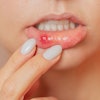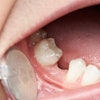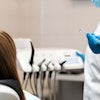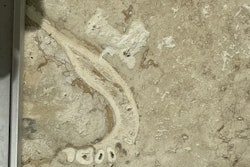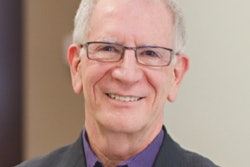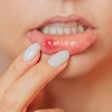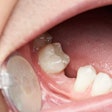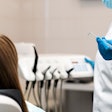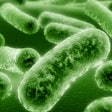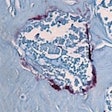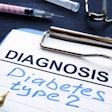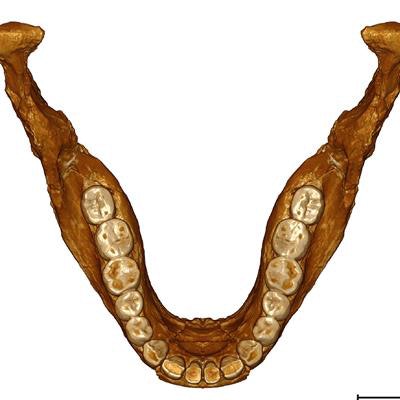
Meet one of your primal ancestors. He's not your immediate relative, but he may be the origin of the human species. The picture below is his lower jaw (i.e., mandible).
 The first, almost complete adult mandible discovered at the archaeological site of Jebel Irhoud, Morocco. Photo credit: Jean-Jacques Hublin, MPI EVA Leipzig. All images courtesy of Max Planck Institute for Evolutionary Anthropology.
The first, almost complete adult mandible discovered at the archaeological site of Jebel Irhoud, Morocco. Photo credit: Jean-Jacques Hublin, MPI EVA Leipzig. All images courtesy of Max Planck Institute for Evolutionary Anthropology.This mandible is the oldest discovered remains of Homo sapiens. It was dated to be about 300,000 years old and was unearthed in Morocco.1
Let me personalize this guy. I'll call him Rick.
Rick's dental health
I don't know how old Rick was when he died. But by looking at Rick's teeth, I would say he was at least 25 years old. I may be way wrong. He may be much older! Here is my reasoning.
Rick has all 16 of his lower teeth. The third molars (i.e., wisdom teeth), which are the last teeth to erupt in human jaws, appear in the mouth between the ages of 17 and 21. The red arrows in the picture below point to the wisdom teeth. So he is at least 17 to 21 years old.
 Photo credit: Jean-Jacques Hublin, MPI EVA Leipzig. Arrows added by Dr. Alvin Danenberg.
Photo credit: Jean-Jacques Hublin, MPI EVA Leipzig. Arrows added by Dr. Alvin Danenberg.In addition, all the mandibular teeth have significant wear on the chewing surfaces. The wear patterns occur from chewing hard foods for a long time. Because of this, my guess is that he is at least in his mid-20s.
But there is a fascinating lack of dental disease in this jaw. Rick does not have any tooth decay or periodontal disease that I can see. How can I tell?
Look at the yellow arrows in the picture below.
 Photo credit: Jean-Jacques Hublin, MPI EVA Leipzig. Arrows added by Dr. Alvin Danenberg.
Photo credit: Jean-Jacques Hublin, MPI EVA Leipzig. Arrows added by Dr. Alvin Danenberg.The yellow arrows point to healthy jawbone surrounding the roots of the teeth. If Rick had periodontal disease, the bone around the teeth would be melting away from the infection associated with periodontal disease. And if he had tooth decay, I would see an obvious breakdown in the enamel structures of the teeth, which is not evident in these photos.
So the next big question is why Rick has no tooth decay and no periodontal disease.
We know that Rick did not go to his dental cave to have his teeth cleaned every six months or to have fluoride applied to his teeth to prevent decay. We also know that Rick didn't have a toothbrush or dental floss to keep unhealthy dental plaque from building up around his teeth.
Look at the blue arrows in the picture below.
 Photo credit: Jean-Jacques Hublin, MPI EVA Leipzig. Arrows added by Dr. Alvin Danenberg.
Photo credit: Jean-Jacques Hublin, MPI EVA Leipzig. Arrows added by Dr. Alvin Danenberg.The blue arrows point to some "junk" between the teeth at the bone level. I believe this is dental calculus (i.e., dental tartar), which is the calcified dental plaque that was present in his mouth while he was alive.
Yes, dental plaque was present in Rick's mouth, and he didn't have tooth decay or periodontal disease.
How could that be? Doesn't dental plaque cause tooth decay and periodontal disease?
Dental plaque is healthy, until it's not
Diet and the health of the gut play important roles in the health of the mouth. Rick did not eat the junk food that civilized societies eat today. Also, his food didn't include chemicals that are abundant in our food supply.
 Dr. Alvin Danenberg.
Dr. Alvin Danenberg.In addition, Rick primarily ate large animals, nose-to-tail. We now know this from the research that Dr. Miki Ben-Dor published in his March 2021 peer-reviewed article in the American Journal of Physical Anthropology.
Rick and his contemporaries had ideal nutrition. Since their diets were healthy, their gut microbiomes were healthy. I can assume their gardens of gut bacteria were balanced and flourishing.
A nutritious diet and robust gut allowed our primal ancestors' immune systems to function at peak performance. A healthy diet, a thriving gut microbiome, and an efficient immune system would create a balance in their mouth bacteria. Essentially, all cells in the body communicate with one another in some fashion.
Rick's healthy dental plaque around his teeth helped prevent tooth decay and periodontal disease. Healthy dental plaque is a natural biofilm, which provides the following three primary functions:
- The hundreds of bacterial species in healthy dental plaque together produce hydrogen peroxide to kill any invading pathogenic bacteria from getting into the gum crevices. If infection penetrated the gum margins around the teeth, it could lead to infection spreading under the gum, destroying the jawbone, and entering the blood system.
- Chemical buffers in healthy dental plaque help prevent acid levels from dropping below a pH of 5.5 around the teeth, which then could cause tooth decay.
- Healthy dental plaque acts as a gatekeeper allowing minerals from the saliva to enter the root surfaces 24 hours a day, seven days a week to remineralize the tooth as needed.
In the U.S. today, poor diets and gut dysbiosis are rampant. The result is a compromised immune system, which leads to a leaky gut and chronic systemic inflammation. Systemic inflammation affects the mouth bacteria negatively and allows potentially pathogenic microbes to overgrow. In this compromised state, dental plaque changes into an unhealthy biofilm that causes tooth decay and periodontal disease. And the overgrowth of pathogenic microbes is fed by a poor diet consisting especially of refined sugar.
So why didn't Rick have visible dental disease?
Based on the images, my takeaway is that Rick had no visible dental disease for the following reasons:
- His diet was nutritious and anti-inflammatory.
- His gut bacteria were in balance and supported healthy digestion, absorption of necessary nutrients, and an intact gut lining.
- His immune system efficiently defended him from outside invading microbes.
- His healthy biofilm around his teeth (i.e., healthy dental plaque) maintained an environment of protection from tooth decay and periodontal disease.
If we were to change our diet and lifestyle, we could prevent dental diseases and most other chronic diseases from getting a foothold. This may sound like Pollyanna talk, but it is possible and doable. An effort needs to be made, but you can achieve it.
References
- Richter D, Grün R, Joannes-Boyau R, et al. The age of the hominin fossils from Jebel Irhoud, Morocco, and the origins of the Middle Stone Age. Nature. 2017;546(7657):293-296. doi:10.1038/nature22335.
Dr. Alvin Danenberg has retired from the private practice of periodontics in Bluffton, SC. He continues to be on the faculty of the College of Integrative Medicine and created its integrative periodontal teaching module. He also spent two years as chief of periodontics at Charleston Air Force Base earlier in his career. His website is drdanenberg.com.
The comments and observations expressed herein do not necessarily reflect the opinions of DrBicuspid.com, nor should they be construed as an endorsement or admonishment of any particular idea, vendor, or organization.
